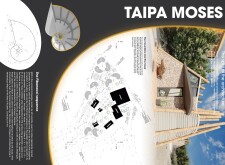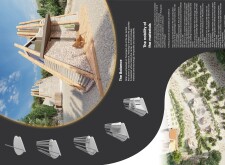5 key facts about this project
Vale de Moses is located in a peaceful area of Portugal, designed as a retreat for meditation and community. The project emphasizes harmony with the natural surroundings, carefully integrating architecture into the landscape. The design concept focuses on creating spaces that foster tranquility and connections among visitors, allowing for personal reflection and shared experiences.
Site Development
The layout includes irregular courtyards situated between the cabins, which are deliberately arranged to take advantage of natural light and airflow. This open design invites users to interact with each other while enjoying the beauty of the outdoors. Each cabin is shaped to reflect the surrounding mountains and forests, promoting a sense of unity with the landscape.
Mathematical Influence
An important aspect of the design is the use of the Fibonacci sequence. This mathematical principle influences the proportions and layout of the cabins, adding a layer of meaning to the overall structure. The design captures the essence of growth found in nature, ensuring that each cabin complements the other. The central fireplace acts as a focal point, drawing attention and warmth to the gathering spaces.
Sustainability and Materiality
Sustainability plays a vital role in the project's construction, particularly through the use of earthbag technology. This method incorporates local materials, which minimizes the environmental impact from transportation. Earthbag structures provide excellent thermal mass, helping to regulate temperature and enhance durability. The construction encourages community participation, allowing visitors to engage with the building process and feel a sense of belonging.
Emotional Engagement
Key elements within the design promote emotional connection and reflection. Features like a round fountain and a circular labyrinth are integrated into the layout, enriching the visual landscape while offering spaces for contemplation. These water features not only enhance aesthetics but also provide a calming atmosphere for visitors. Spaces are created to encourage moments of quiet and introspection, inviting guests to fully engage with their surroundings.






















































